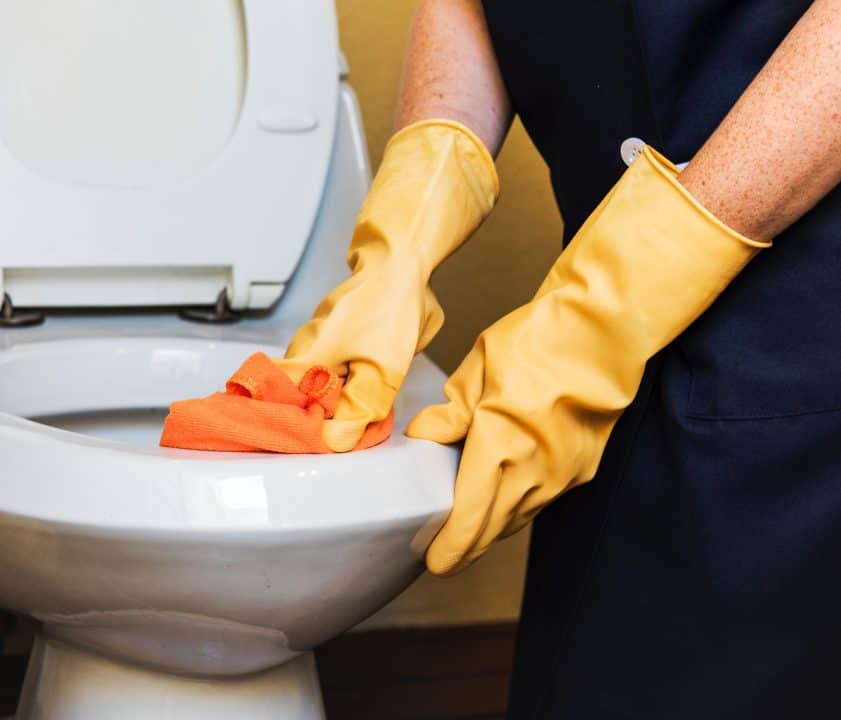In modern times, every household needs plumbing. And with that, they’ll also want the conveniences of owning their own bathtub and toilet.
While plumbing has improved significantly in the past few years, there are still plenty of things that can go wrong. One of the most common problems associated with the toilet is sweating. If things are not perfect, there is a really good chance that your toilet’s tank is going to sweat. So, what can you do about toilet tank sweating?
What damage could potentially be done? Toilet sweating might not seem like a big deal, but it is. In fact, it will cause huge problems if you ignore it. Within this guide, you’re going to learn about the causes and potential solutions to the problem at hand.
What Causes A Sweating Toilet?
Before attempting to find a solution to the toilet sweating, you should find out what the problem is anyway. What could potentially make the tank sweat? Is there a leak? Could it have something to do with humidity? The truth of the matter is that there are numerous possible reasons. Below, you’ll learn more about these reasons so you can pinpoint the source of your unique problem.
While it depends on the situation at hand, the most common culprit of sweat is temperature. In general, water is going to enter the tank at a pretty low temperature. Anywhere from 40 to 50 is common. After that, there is a good chance that your home’s temperature is going to be much higher. This is going to create condensation and that will ultimately cause the toilet to sweat bullets. The warmer air inside of your home will make contact with the toilet’s tank and that will make the tank sweat. In return, you’re going to find drips of water on your bathroom floor.
Leaks are another problem, but they’re easier to diagnose. Leaks may be much easier to fix as well. Still, you need to identify and remedy the problem as quickly as possible. Identifying the precise cause in advance will make fixing the issue so much easier.
Why It’s A Problem
Initially, you may feel that the toilet sweat isn’t that big of an issue.
After all, you can just wipe up the water using a paper towel or dish cloth. After that, everything will start over again. This is a bad attitude to have. After all, the moisture can cause a lot of headaches for you in the future. Most people are aware of the fact that mold and mildew are dangerous and destructive. You need to understand that both of these are caused by excess moisture.
If your bathroom has too much moisture, there is a high risk that it is going to develop mold or mildew in the future. At the same time, you have to be worried about the floor underneath the toilet. If the problem is not rectified permanently, there is a chance that the floor is going to start to rot. Combine this with the immense dangers of mold and you’ll agree that something needs to be done about the problem right away.
After all, you would not want to expose your loved ones to these dangers. In the short-term, you already know how annoying it is to get your shirt and pants wet everything you sit down to use the toilet. Fixing the problem as quickly as possible is recommended. Thankfully, this is a problem that isn’t too difficult to fix.
How To Stop Your Toilet From Sweating
If excess moisture is building up on your toilet tank, the problem is most likely associated with high humidity.
To correct this problem, a dehumidifier should be placed in the bathroom in close proximity of the toilet. This will help reduce the humidity significantly.
Other ways to correct the problem is with outside venting. If your bathroom does not have an existing vent fan in place, you will need to install one as soon as possible. The vent fan will pull warm, humid air from showers out of the room and to the outside. If you do not know which of these two corrective measures will work, you could combine them together to achieve better results.
Reducing the humidity in your bathroom is pertinent to preventing the excess moisture to build up on the toilet tank. Consider reducing your shower time by a few minutes and opening a window to allow the humidity to warm, humid air from the shower to escape outside. However, this measure will only work when the outside humidity is low.
If you’re unable to find a solution to the problem by working on the outside, you should target the tank directly. After all, it is the source of the problem. If you can potentially increase the temperature of the water in the tank, you might be able to stop the problem for good. Buying and installing a toilet tank insulation kit can help. You can even make your own. Either way, this is one of the quickest and easiest ways to stop the toilet’s tank from sweating.
Remember to drain the water and clean the inside of the tank thoroughly before installing the insulation. Try to remove as much water and moisture as possible before gluing the insulation to the inside of the tank. After that, you’ll need to wait a good 8 to 12 hour before refilling the tank with water. This will give the glue plenty of time to dry.
Summary
Toilet sweating can lead to structural damage if not addressed in a timely manner.
The moisture from the tank will leak down and penetrate into the floor and eventually into the subfloor and walls.
Contrary to believe, the problem can be eliminated with a few tweaks.
Correcting the problem will depend on your budget. If you have a small budget for this project, you should start with the preventive measures that do not cost anything. If this doesn’t work, you will have to transition to the more drastic measures.
The tips above should help you eliminate the excess moisture before it turns into a real problem.
My name is Eugene Thornhill. I'm an outdoor enthusiast who loves nothing more than being one with nature. I've lived in numerous outdoor homes and even constructed my own. Living off-grid is something I'm very familiar with, more so than living in the city. For many years I've dealt with the many problems of living off-grid. It's time to pass on my knowledge through Cabinguides.


